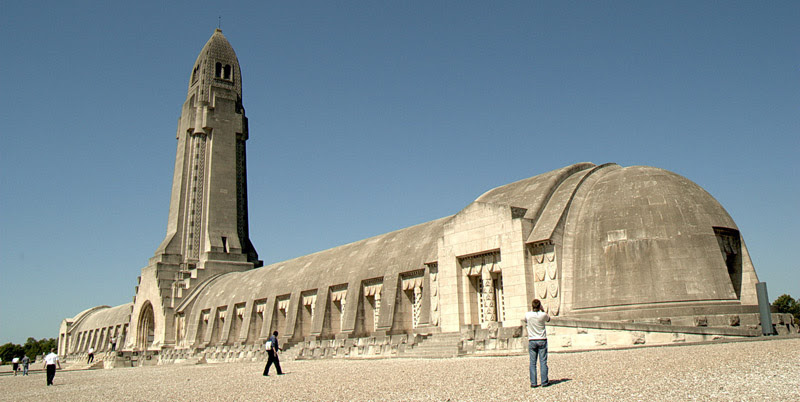I've visited many battlefields over the years, Civil and Revolutionary War in the United States, the D-Day beaches and American Cemetery in Normandy; solemn places, reminding us of the sacrifice of those who fought and died, yet fascinating and instructive and, at times, inspirational. About twenty five years ago, Mrs THC and I were driving from Paris to Alsace. Just off the payage was Verdun and we decided to make a visit. The emotions it invoked were very different from those I'd experienced at other battlefields and we ended our visit earlier than planned.
From February through December of 1916 the Battle of Verdun ground on between the French and German armies. During those months somewhere between 700,000 and 1 million soldiers became casualties with 300,000 killed (about equal to all U.S. combat deaths in the European and Pacific theatres during WWII). Weeks were spent by fighting for gains measured in hundreds of feet and tens of thousands of dead and wounded. At its end the front lines were only a few miles from where they'd been at the start.
We saw a landscape still completely pockmarked by shell holes from the battle's devastating artillery barrages the results of which gave birth to landmarks like (in its English translation), the Forest of Dead Men. A quarter century after our visit the scene looks the same as you can see from this recent picture by Michael St Maur Sheil (for more of his pictures go here). A century after the battle sixty five square miles around the town are still prohibited for any use due to the density of unexploded munitions.

The relentless artillery and machine gun fire pounded the bodies of dead soldiers into unrecognizable fragments embedded in the endless mud that covered the entire battlefield. After the war the Douamont Ossuary was constructed to house the bones recovered from at least 130,000 unidentified combatants of both sides.
The sense of waste, loss and despair at Verdun is overwhelming and we left there depressed.
The Ossuary

During four years of war more than 800,000 British soldiers would die, including Wilfred Owen, author of Dolce et Decorum Est. Volunteering for the army in October 1915, he reached the front lines in France in late 1916 seeing extensive combat and enduring horrific experiences culminating in being blown into the air by an exploding shell. Diagnosed with shell shock, Wilfred was sent to Craiglockhart Military Hospital in Edinburgh where he was befriended by fellow poet Siegfried Sassoon. Returning to the front lines in August 1918 Wilfred participated in the final campaigns of the war. Leading his company in action during October he captured an enemy machine gun which he used to kill several German soldiers, an action for which he was posthumously awarded the Military Cross. He wrote frequently to his mother of his life at war; from a letter of October 8, 1918 (quoted by Ferdinand Mount in his review of an Owen biography in the Wall St Journal, March 29, 2014):
"All one day we could not move from a small trench, though hour by hour the wounded were groaning just outside. Three stretcher-bearers who got up were hit, one after one. I had to order no one to show himself after that, but remembering my own duty, and remembering also my forefathers the agile Welshmen of the mountains I scrambled out myself & felt an exhilaration in baffling the Machine Guns by quick bounds from cover to cover. After the shells we had been through and the gas, bullets were like the gentle rain from heaven."
Wilfred was killed on November 4, 1918 while leading his troops in a crossing of the Sambre Canal in Belgium. He was 25 years old. Word of his death reached his parents on November 11 while the bells were ringing, celebrating the Armistice and the end of the war.
Dolce et Decorum Est
Bent double, like old beggars under sacks,
Knock-kneed, coughing like hags, we cursed through sludge,
Till on the haunting flares we turned our backs
And towards our distant rest began to trudge.
Men marched asleep. Many had lost their boots
But limped on, blood-shod. All went lame; all blind;
Drunk with fatigue; deaf even to the hoots
Of disappointed shells that dropped behind.
GAS! Gas! Quick, boys!-- An ecstasy of fumbling,
Fitting the clumsy helmets just in time;
But someone still was yelling out and stumbling
And floundering like a man in fire or lime.--
Dim, through the misty panes and thick green light
As under a green sea, I saw him drowning.
In all my dreams, before my helpless sight,
He plunges at me, guttering, choking, drowning.
If in some smothering dreams you too could pace
Behind the wagon that we flung him in,
And watch the white eyes writhing in his face,
His hanging face, like a devil's sick of sin;
If you could hear, at every jolt, the blood
Come gargling from the froth-corrupted lungs,
Obscene as cancer, bitter as the cud
Of vile, incurable sores on innocent tongues,--
My friend, you would not tell with such high zest
To children ardent for some desperate glory,
The old Lie: Dulce et decorum est
Pro patria mori.
No comments:
Post a Comment